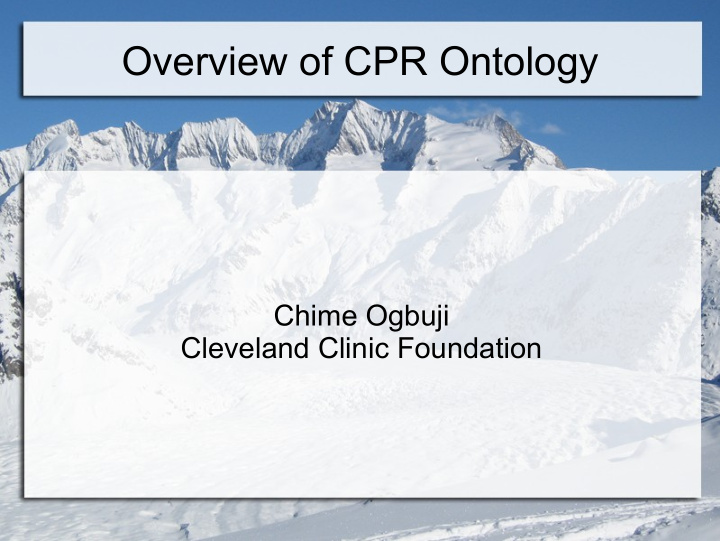



Overview of CPR Ontology Chime Ogbuji Cleveland Clinic Foundation
What is a CPR? Computer-based Patient Record (CPR): An electronic patient record that resides in a system specifically designed to support users by providing accessibility to complete and accurate data, alerts, reminders, clinical decision support systems, links to medical knowledge, and other aids. - Institute of Medicine (IOM) 1997 Defines medical records systems of the future and the important features that distinguish them for EHRs of 1997
What is the CPR Ontology? ● Addresses terminology requirements of a CPR ● IOM defines a set of requirements for CPR systems regarding record content – Uniform, core data elements – Standardized coding systems and formats – A common data dictionary – Information on outcomes of care and functional status
What is the CPR Ontology? ● Defines a minimal set of terms ● Provide principled, ontological commitment for the terms used in many of the healthcare information terminology systems ● Relies on the use of foundational ontologies and ontology engineering best practices. ● An upper ontology of clinical medicine – Similar motivation as OGMS
CPR Ontology goals ● In order to achieve uniformity , it needs to have significant coverage – Pyramid ontology paradigm: small, well- organized top; wide, idiosyncratic bottom. ● Adopt cogent conceptual models that appeal to an ontological study of clinical medicine
Reinventing the Wheel? ● Why not re-use GALEN? – Dated and deprecated ● Why not re-use SNOMED-CT? – Licensing issues and lack of ontological grounding (it lies in towards the bottom of the pyramid) – Issues with inconsistent and incomplete definitions
Framework ● BFO – Domain-independent upper ontology ● BioTop – Integrating foundation for both clinical medicine and the life sciences ● CPR – Clinical medicine: study of medicine based on direct observation of patients
Role of BioTop ● A “ mediating layer for the life sciences domain ” ● Proposed as a candidate upper ontology for SNOMED-CT (covers health care as well) ● Coverage of biology and biomedicine at various levels of granularity ● Bridge between formal, upper ontologies and domain-specific ontologies
BioTop Coverage ● Supports integration of: – Gene Ontology – Cell Ontology – Chemical Entities of Biological Interest
BioTop's Range of Granularity
Method(s) behind the Madness ● Realist ontologies (BFO-based) ● Situations, findings, & observables (Rector 2008) ● Surgical procedures (GALEN) ● Representational artifacts v.s. their referents (Vizeno 2007) ● Problems and screenings (Weed 1968)
Method(s) behind the Madness ● Care act hierarchy and clinical workflow (Bayegan 2002) ● Disease, diagnosis, etiology and the Disease Entity Model (Whitbeck 1977) ● Disease, diagnosis, bodily features, etc. (Scheuermann et al. 2009) ● Integrating anatomy, physiology, and pathology (Rosse et al. 2005)
General Rules of Thumb ● Use realist ontology approach to the extent that distinctions are useful for real-world clinical informatics problems – Avoid reductionism trap ● Validate against data and standard, controlled- vocabularies – Patient data and SNOMED-CT primarily
Patient Care Activity Hierarchy
Clinical Findings
Diseases and Their Manifestations
Signs and Their Recordings
Clinical Investigations and Diagnoses
Validating CPR ● Validated against local controlled vocabulary – Terms used in large, RDF-based HVI patient registry (200,000+ patients) for outcomes research – 4051 OWL classes – Systematically attempted to find a principled location for each class
Validating CPR ● Validated against SNOMED-CT and FMA extracts – Recent research on aligning both ontologies and extracting segments from them – Developed software to perform extraction and place segments within CPR/BioTop/BFO framework ● Opportunity to validate against TMO dataset
Recommend
More recommend